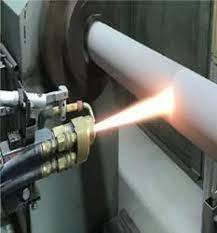India 8690066649 info@sprayblast.in
Our Products

In the aerospace industry, HVOF (High-Velocity Oxygen Fuel) coatings are frequently utilized to improve the performance and longevity of different components, including flap tracks. The movement of the flaps, which are aerodynamic surfaces that may be extended or retracted to alter the lift and drag characteristics of the aircraft, is guided and supported by the flap tracks, which are important structural components of aircraft wings.
Flap tracks are prone to friction and continuous movement, both of which can cause wear over time. HVOF coating may greatly enhance the wear resistance of flap tracks, assuring their dependability and increasing their operating life. They are frequently constructed of strong materials like tungsten carbide. The friction between moving parts can be decreased by coating flap tracks with reduced friction coatings. As a result, component wear is reduced and the flap expansion and retraction process is more effective. Flap tracks on aircraft are frequently exposed to moisture, chemicals, and other corrosive substances while operating in a variety of settings. HVOF coatings serve as a barrier against corrosion, protecting the flap tracks' structural integrity.
Each time the flaps are extended and retracted during a flight, the flap tracks are subjected to cyclic stress. These tracks' fatigue resistance is improved by HVOF coatings, which also stop failures or fractures from forming from repeated stress cycles. When landing suddenly or amid turbulence, HVOF coatings can deflect and disperse impact pressures, protecting the flap tracks from harm. By using HVOF materials to coat flap tracks, regular maintenance, inspections, and replacements are avoided, saving money and minimizing aircraft downtime. In regions of the aircraft where heat generation or exposure to hot exhaust gases is substantial, some HVOF coatings provide resistance to high temperatures and heat.
It is possible to apply HVOF coatings with exact control over thickness and surface quality. The flaps can work more easily when the surface finish is smooth since it lowers the possibility of abrasion or wear-related problems. HVOF coatings can be applied in thin, light layers to achieve the required protective characteristics while reducing the total weight of the aircraft. By shielding flap tracks from the elements including UV rays, rain, and temperature changes, coatings can stop the underlying material from deteriorating. HVOF ceramic coating increase the overall efficiency of the aircraft by guaranteeing that the flaps can work properly and without unnecessary resistance by minimizing wear and friction.
It is possible to apply HVOF coatings with exact control over thickness and surface quality. The flaps can work more easily when the surface finish is smooth since it lowers the possibility of abrasion or wear-related problems. HVOF coatings can be applied in thin, light layers to achieve the required protective characteristics while reducing the total weight of the aircraft. By shielding flap tracks from the elements including UV rays, rain, and temperature changes, coatings can stop the underlying material from deteriorating. HVOF coatings increase the overall efficiency of the aircraft by guaranteeing that the flaps can work properly and without unnecessary resistance by minimizing wear and friction.
HVOF coatings can help the guides that direct the flaps' motion along the intended route. By providing wear resistance, these coatings lessen friction between the flap and the guide. This guarantees a seamless and effective flap procedure. Rollers are frequently used in flap tracks to make moving the flaps easier. These rollers' wear resistance is improved, friction is decreased, and their perfect alignment is maintained by applying HVOF coatings. The wear resistance and corrosion protection of the pivot points within the flap tracks are improved by coating them with HVOF materials. By doing this, it is made sure that the pivot points are stable and free of extra play over time.
Surfaces that come into touch with other components during flap movement can be coated with HVOF. Slide surfaces with coatings operate more smoothly and consistently because they experience less wear, less friction, and less galling. HVOF coatings offer corrosion and wear protection for bearings in flap tracks, extending their lifespan and preserving their capacity for load-bearing. The flap tracks are kept firmly connected to the structure of the airplane by coatings on the attachment points. HVOF coatings help keep these important connections structurally sound. Flap tracks are subject to external elements including moisture and impurities. By serving as a barrier of defense against corrosion and preserving the structural integrity of the flap tracks, HVOF coatings serve as a protective layer.
HVOF coatings can be applied in a deliberate manner to disperse stress more uniformly throughout the flap track surface, minimizing localized wear and consequent fatigue. HVOF coatings may be designed to offer the necessary protective qualities while adding the least amount of weight to the structure of the aircraft. HVOF coatings increase the overall effectiveness of flap track systems by lowering wear and friction. As a result, flap movement is more fluid, less energy is used, and aerodynamic performance is enhanced. The use of thermal spray coating on flap tracks is a beneficial procedure since they are put through harsh operational circumstances in the aerospace sector. The design of the aircraft, the materials used to manufacture the flap track, operating needs, and regulatory considerations all have a role in the coating material selection and the individual components that need to be coated.